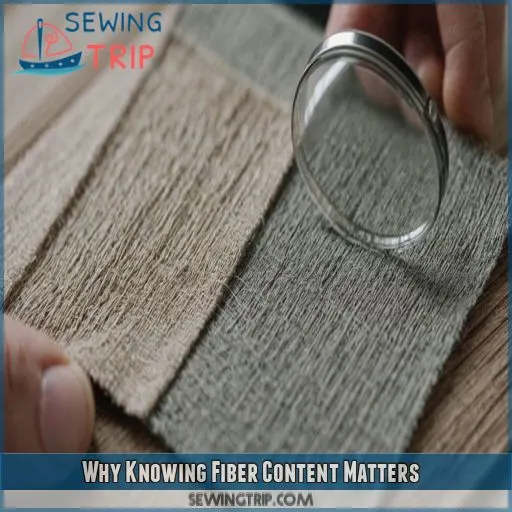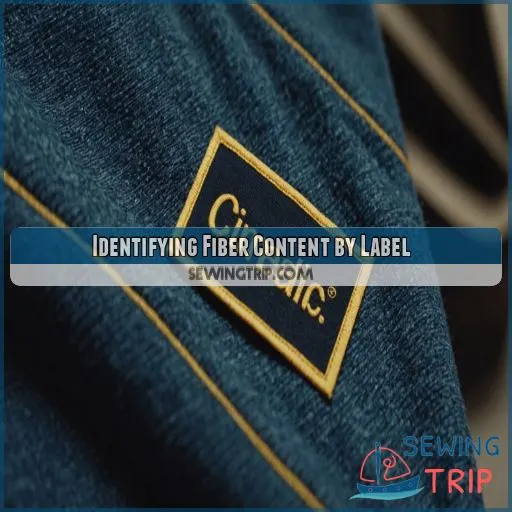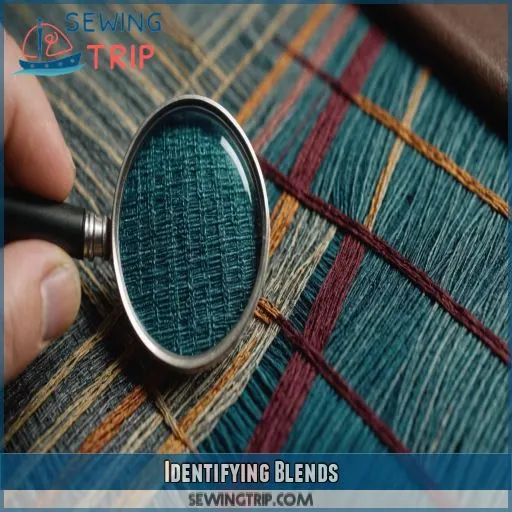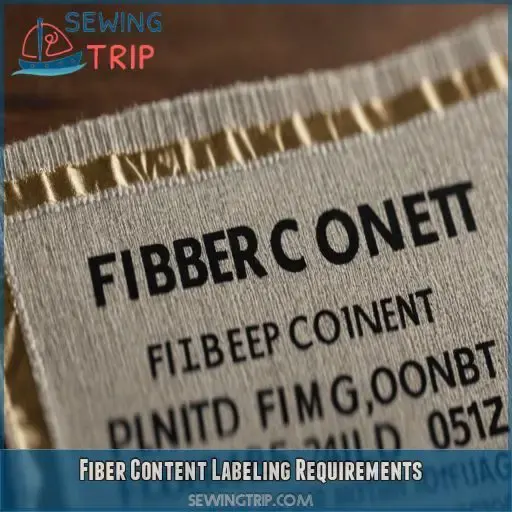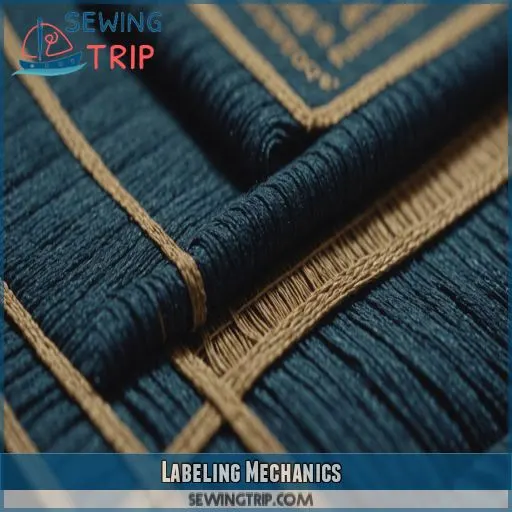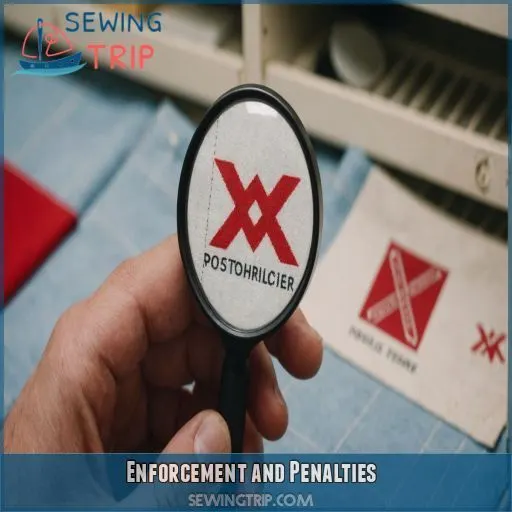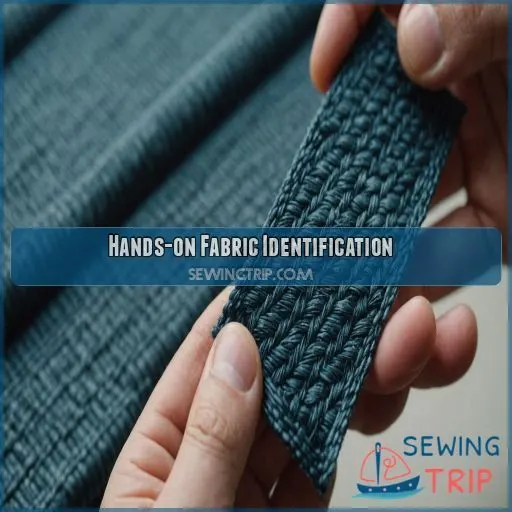This site is supported by our readers. We may earn a commission, at no cost to you, if you purchase through links.
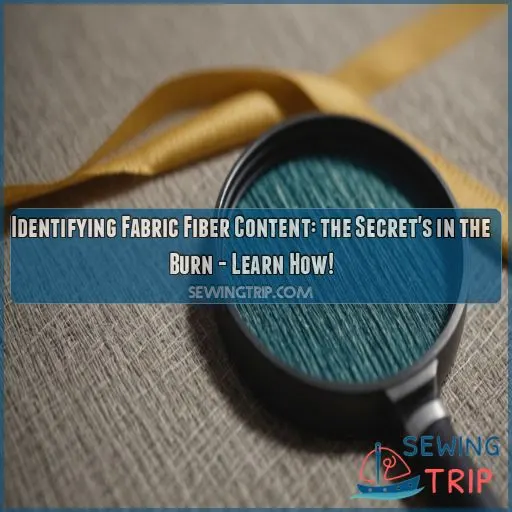 You’re probably wondering why fabric fiber content matters.
You’re probably wondering why fabric fiber content matters.
It’s really important for making smart decisions about fabric care and what you use it for.
To figure out what a fabric is made of, start by checking the label or asking the store staff.
If that doesn’t work, try the burn test – it’s like a mini science experiment.
Natural fibers like cotton and linen smell earthy when you burn them, while synthetics like polyester and nylon smell more chemical.
Want to become a fabric detective and learn more about fibers?
Let’s get started and explore the different kinds of fibers!
Table Of Contents
Key Takeaways
- Don’t get caught with your pants down – or should I say, with a fabric that’s not what you thought it was! Always check the label or perform a Burn Test to identify the fiber content, especially when thrift shopping or repurposing old clothes.
- When it comes to fabric care, knowing the fiber content is like having a superpower. It helps you make informed decisions about washing, drying, and ironing, and can even prevent costly mistakes like shrinkage or damage.
- Blends can be tricky to identify, so don’t rely solely on the burn test. Use a combination of visual inspection, touch, and research to figure out what you’re working with. And remember, even the best detectives need a little help sometimes!
- Accurate labeling is key to avoiding costly mistakes and ensuring fair competition in the textile industry. So, whether you’re a consumer or a manufacturer, make sure you’re following the rules and labeling your fabrics correctly. Your wallet – and the environment – will thank you!
Why Knowing Fiber Content Matters
When you’re working with fabrics, knowing the fiber content is really important to make sure you’re using the right materials for your project. Whether you’re quilting, repurposing old clothes, or shopping at thrift stores, understanding fiber content helps you make informed decisions about care, maintenance, and suitability for your needs.
Importance of Accurate Labeling
Accurate labeling matters because it builds consumer trust and makes sure you’re following the rules.
Knowing the fiber content helps you care for your fabrics properly, which affects product quality and how long they last.
It also impacts brand reputation and fair competition.
By understanding what’s in your fabric, you can make informed decisions and avoid costly mistakes.
Check those labels carefully!
Consequences of Mislabeling
Mislabeling fabric fiber content can have serious consequences. You might end up with a garment that shrinks unexpectedly, causes allergic reactions, or falls apart quickly. Inaccurate care instructions can ruin a perfectly good fabric. Knowing the fabric content helps you get the performance you expect. Accurate fiber content disclosure is key to making informed purchasing decisions.
Impact on Care and Maintenance
Knowing the fiber content of your fabric is really important for proper care and maintenance.
Washing, drying, and ironing can be a disaster if you don’t know what you’re dealing with.
A burn test can help you figure out the fiber content and make sure you’re not ruining your fabric.
This means longer fabric longevity and fewer headaches with stain removal.
Identifying Fiber Content by Label
You can often find the fiber content of a fabric by checking the label.
The label is usually located at the end of a fabric bolt or on the care label of a garment.
However, labels can be missing or inaccurate, especially on thrift store finds, scraps, or repurposed old clothes.
This is why it’s important to know how to identify fibers through other means.
Fabric Bolts and Cuts of Fabric
When shopping for fabric, check the bolt end for labels that reveal the fiber content. Fabric cuts mightn’t be labeled, but you can ask the store staff for information. Look for fabric content tags or ask for a sample to perform a burn test. This helps you make sure you’re getting the right fabric for your project.
Clothing and Thrift Store Items
Figuring out what a piece of clothing is made of can be tricky, especially when you’re dealing with thrift store finds. You might stumble upon a vintage gem with a faded label or a second-hand item with no label at all. Here are some tips to help you out:
- Check the care label for any clues about the fabric content.
- Look for a label with the fiber content percentage, such as "80% cotton, 20% polyester".
- Research the era and style of the garment to narrow down possible fabric types.
- If all else fails, consider performing a burn test to determine the fiber content.
The Burn Test: a Reliable Method
You’ve got a mystery fabric with unknown fibers, and the label’s nowhere to be found.
That’s where the burn test comes in, a reliable method to uncover the truth about your fabric’s fiber content.
Safety Precautions
When performing a burn test, safety comes first! Make sure you have good ventilation, have a fire extinguisher nearby, and wear protective gear like gloves and goggles. Choose an open space with a water source close by. Here’s a quick checklist:
| Safety Precautions | Why It Matters |
|---|---|
| Ventilation | Prevents inhaling toxic fumes |
| Fire Extinguisher | Quickly puts out unexpected flames |
| Protective Gear | Safeguards your skin and eyes |
| Open Space | Reduces risk of accidental fires spreading |
Burning Behavior and Smell
When you burn fabric, the smell can give away its fiber content. Natural fibers like cotton and linen produce a earthy, burning-wood smell, while synthetic fibers like polyester and nylon give off a chemical, plastic-like odor. Pay attention to the intensity and character of the smell to help identify the fabric’s composition.
Ash Residue Analysis
When analyzing ash residue, you’ll notice different types of ash depending on the fiber content. Natural fibers like cotton and wool produce a light, fluffy ash, while synthetic fibers like polyester and nylon produce a harder, more brittle ash. Here are some key differences to look out for:
- Cotton ash is light and fluffy, with a tendency to disintegrate quickly.
- Wool ash is slightly darker and more powdery than cotton ash.
- Synthetic fibers produce a hard, brittle ash that doesn’t disintegrate easily.
Identifying Blends
When you’re trying to identify blends, the burn test can be a bit tricky – it’s not always possible to pinpoint the exact fibers with 100% certainty. To get a better sense of what you’re working with, you’ll want to combine the burn test with some old-fashioned detective work, like visual inspection and research.
Burn Test Limitations
The burn test isn’t foolproof, especially with blends. You might get a mixed signal, making it tough to identify the fibers with certainty. That’s because blended fibers can exhibit characteristics from multiple fibers, making the burn test less reliable. In these cases, you’ll need to dig deeper to figure out what you’re working with.
Visual Inspection and Touch Test
When identifying blends, don’t rely solely on the burn test. Use your senses to inspect the fabric visually and by touch. Here are three tips to get you started:
- Fabric texture: Blends can have a unique texture that’s different from their individual components.
- Sheen variations: Observe how light reflects off the fabric to determine if it’s a blend.
- Fiber feel: Experience can help you identify fibers by touch, but be aware that blends can be tricky to pinpoint.
Research and Labeling
When identifying blends, research and labeling are key.
Look for labels that provide fabric composition details.
Check online resources for textile regulations and sourcing transparency.
Verify country of origin labeling and yarn details to make sure they’re accurate.
Consult a fabric catalog or expert if needed.
Accurate labeling helps you stay in line with textile rules and helps you make informed choices.
Fiber Content Labeling Requirements
Buying fabric can be a bit tricky, you want to know exactly what you’re getting, right? That’s where fiber content labeling requirements come in handy – they give you the info you need to make smart choices. In this section, we’ll break down the rules and regulations around fiber content labeling, so you can feel confident about your fabric purchases.
General Requirements
When you’re looking at fabric content labels, there are some basic rules you need to know.
Most clothing and textile products have to list the generic fiber names and percentages by weight of each fiber they’re made of.
This rule applies to fibers in yarns, fabrics, clothing, and other household items.
Only fibers making up 5% or more of the total fiber weight have to be listed.
Exceptions to Fiber Disclosure
When it comes to fiber content labeling, there are some exceptions to the rule. You don’t need to disclose fiber content for:
- Trimmings and ornamentation that don’t exceed 15% of the surface area.
- Linings, interlinings, fillings, or paddings used solely for structural purposes.
- Elastic materials or separate sections with different fiber compositions, which require separate label identification.
Country of Origin Labeling
If you’re dealing with country of origin labeling, you need to know the rules.
Products covered by the Textile and Wool Acts must be labeled with their country of origin.
If you’re importing products, you’ll need to identify the country of processing or manufacturing.
This labeling helps ensure Fair Trade practices and supports Consumer Choice, promoting Ethical Sourcing and reducing Global Impact.
Labeling Mechanics
Fabric fiber content labeling has its own set of rules. You need to know these rules to avoid mistakes and stay out of trouble. In this section, we’ll break down the labeling mechanics, covering placement and legibility, attachment, and security, so you can confidently label your fabrics and stay on the right side of the law.
Placement and Legibility
When it comes to labeling mechanics, placement and legibility are key. You want to make sure the label is easy to read and understand. Here are some tips to keep in mind:
- The three required disclosures (fiber content, country of origin, and care instructions) can be on one label or separate labels.
- Fiber content information must be in equal size and conspicuousness lettering.
- The country of origin must be on the front of the label.
- All information must be clearly legible, conspicuous, and readily accessible to the consumer.
Attachment and Security
Now that you know where to place your labels, let’s talk about attachment and security.
Your labels should be securely attached to the product until it reaches the consumer.
No need for permanent attachment, but make sure they don’t come off easily.
This will help the label stay put, providing the consumer with essential information about fiber content, care instructions, and country of origin.
Enforcement and Penalties
If you’re not accurately labeling your fabrics, you could be facing serious consequences – from administrative orders to hefty fines. Understanding the enforcement and penalties surrounding fabric content labeling can help you avoid costly mistakes and make sure you’re complying with the law.
Violation Consequences
Breaking textile rules can lead to serious consequences.
You could face legal actions, financial penalties, and damage to your brand reputation.
Consumer complaints can also harm your business.
Make sure you follow fabric fiber content guidelines to avoid these costly mistakes and maintain a positive industry impact.
Administrative Orders and Fines
If you’re found violating textile labeling rules, you might face administrative orders that prohibit the violating act or practice. Failing to comply can result in fines of up to $51,744 per violation. These enforcement actions protect consumers and make sure fair competition in the textile industry. You need to understand compliance risks and take steps to avoid legal repercussions.
Improperly Labeled Imported Items
Importing fabrics? You need to get your labeling right to avoid trouble. If the labels aren’t accurate, you could face some serious issues:
- Detention of goods: Customs can hold your shipment if labels are inaccurate or missing.
- Liquidated damages: You may face fines for non-compliance, which can be costly.
- Loss of business reputation: Repeated offenses can damage your reputation and lead to loss of customer trust.
Hands-on Fabric Identification
You’re about to get hands-on with fabric identification, and it’s easier than you think. By using simple tests like touch, heating, and burning, you’ll be able to figure out what your fabric is made of and make informed decisions about how to care for it.
Touch and Heating Tests
Get hands-on with fabric identification! Touch and heating tests can reveal a fabric’s secrets. Run your hand over the fabric to feel its texture – silk is smooth, cotton is soft, and wool is warm. Apply heat and observe how it responds. Natural fibers like cotton and wool will burn, while synthetics like polyester will melt.
Chemical Tests
Now that you’ve tried the touch and heating tests, let’s get chemical! Chemical tests can help identify fabric fiber content, but it’s important to follow safety precautions. DIY chemical kits are available, but be aware of their limitations. Different fabrics react differently to chemicals, so it’s key to research the specific test for your fabric.
Fabric Labels and Online Guides
You want to know what’s in your clothes?
Don’t just take the fabric label at face value – they can be wrong or misleading.
Online guides can be helpful, but keep in mind that there are language differences and varying levels of accuracy.
To get a clearer picture, combine the label information with burn tests and other hands-on methods.
Check out textile rules and trusted fabric resources for guidance.
Frequently Asked Questions (FAQs)
How do you know if a fabric has a fiber content?
You can identify a fabric’s fiber content by checking the label, performing a burn test, or doing a touch test. Labels usually list the fibers, while burn tests reveal distinct smells and ash types, and touch tests help you feel the difference.
What is the recommended average fiber intake?
You’re probably thinking of dietary fiber, not fabric fiber! The daily recommended average fiber intake is 25-30 grams, but don’t worry, you can easily boost your intake with fruits, veggies, and whole grains.
How do you identify a fiber?
To identify a fiber, you’ll need to perform a burn test, observing how it burns, smells, and the type of ash it produces. You can also check the fabric label or consult with a fabric expert for guidance.
How to identify textile fibers in a garment?
You’re about to uncover the secrets of your garment’s DNA! To identify textile fibers, start by checking the care label, then perform a burn test, and finally, inspect the fabric’s texture and sheen for clues.
How to tell the fiber content of fabric?
Want to know the fiber content of your fabric? Check the label or perform a burn test! Different fibers burn and smell distinctively. You can also use a touch test or chemical tests for a more accurate identification.
How to identify fabric content?
Imagine being a fabric detective, sleuthing out the secrets of your favorite fabrics. To identify fabric content, start by checking the label, then perform a burn test, and finally, inspect the fabric’s texture and sheen.
How do you determine the fiber content?
To determine fiber content, you’ll want to check the fabric label or perform a burn test, observing how the fabric burns, smells, and leaves ash. You can also use a touch test or chemical tests for more accuracy.
How can you identify a specific fiber?
Ironically, the secret to identifying a specific fiber lies in setting it on fire – literally! Perform a burn test, observe the flame, smell, and ash, and match the results to a reliable burn chart for accurate identification.
Can I use a single burn test for multiple fibers?
You can’t rely on a single burn test to identify multiple fibers, as different fibers have unique burning behaviors. Do separate burn tests for each fiber to get a clear picture and avoid getting mixed up.
How accurate are smartphone apps for identifying fabric content?
You’re a detective searching for clues in the fabric world. Unfortunately, smartphone apps aren’t the superpower you’re looking for – they’re not always accurate. Stick to the burn test and labeling for a more reliable verdict.
What are the limitations of using a fabrics texture alone?
Relying solely on a fabric’s texture can be misleading, as blends can mimic natural fibers. You might mistake a soft polyester for cotton or a smooth nylon for silk, so you need to use multiple identification methods.
Can fabric softener or detergent affect burn test results?
You’re wondering if fabric softener or detergent can skew burn test results? The answer is yes. Residue from these products can affect how fabrics burn, leading to inaccurate results, so make sure to test untreated samples.
Are there any health risks associated with burning synthetic fibers?
Burning synthetic fibers can release toxic fumes, so take precautions. When performing a burn test, work in a well-ventilated area, and avoid inhaling fumes. Your health is worth it – prioritize caution and safety.
Conclusion
You’re now a fabric detective, equipped to uncover the secrets of identifying fabric fiber content.
When in doubt, give it a sniff" – and a burn test, of course!
From natural fibers to synthetic blends, you’ve got the know-how to make informed decisions about fabric care and usage.
Happy sleuthing, and don’t forget to burn responsibly!

